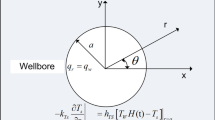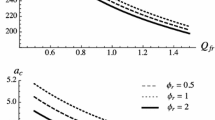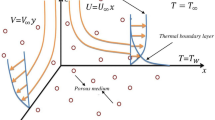Abstract
In a geothermal reservoir, the heat pipe mechanism can transfer heat very efficiently, with vapor rising and liquid falling in comparable quantities, driven by gravity. For a given heat and mass flux that is not too large, there are two possible steady solutions with vapor-liquid counterflow, one liquid-dominated, and one vapor-dominated. Numerical solution of the equations for two-phase vertical counterflow displays intriguing stability behaviour. If pressure and saturation are fixed at depth, and heat and mass flux specified at the top, the vapor-dominated solution is almost always obtained. That is, for a variety of boundary values, the solution settles to the vapor-dominated steady-state, and only for very special values is it possible to obtain the liquid-dominated case. Similarly the liquid-dominated solution is almost always obtained if the boundary conditions are reversed, with pressure and saturation fixed at the top and heat and mass flux specified at depth.
This behaviour is here explained in two complementary ways. It is shown to be a consequence of upstream differencing of the flow terms in the numerical method. It is also shown to be expected behaviour for wavelike saturation solutions. Hence the observed behaviour is not only a direct consequence of the numerical method used, but is fundamental to geothermal heat pipes.
Similar content being viewed by others
Abbreviations
- A :
-
a constant
- c :
-
characteristic velocity
- C :
-
a constant
- d:
-
darcy, 10−12 m2, a unit for permeability
- D :
-
diffusivity
- E :
-
energy density
- F :
-
mass flux density
- h :
-
specific enthalpy
- g :
-
gravitational constant
- k :
-
permeability
- k r :
-
relative permeability
- M :
-
mass density
- p :
-
pressure
- s :
-
liquid saturation
- U :
-
specific internal energy
- z, t :
-
independent variables
- δz :
-
distance between grid block centers
- Q :
-
flux density
- α :
-
a constant
- Β :
-
a dummy subscript for phase
- λ :
-
mobility
- Μ :
-
dynamic viscosity
- v :
-
kinematic viscosity
- Φ :
-
porosity
- σ :
-
≡1/gl
- ρ :
-
density
References
Aziz, K. and Settari, T., 1979,Petroleum Reservoir Simulation, Applied Science Publishers, London.
Blakeley, M., 1986, Geothermal reservoir modelling, PhD thesis, Dept. of Theoretical and Applied Mathematics, Auckland University.
Bodvarsson, G. S., Pruess, K., Stefansson, V., Björnsson, S. and Ojiambo, S. B., 1987, East Olkaria geothermal field, Kenya. 1. History match with production and pressure decline data,J. Geophys. Res. 92(B1), 521–539.
Bodvarsson, G. S., Pruess, K., Lippmann, M. J. and Björnsson, S., 1982, Improved energy recovery from geothermal reservoirs,J. Petroleum Tech. 34(9), 1920–1928.
Crichlow, H. B., 1977,Modern Reservoir Engineering — A Simulation Approach, Prentice-Hall, Englewood Cliffs, New Jersey.
de Marsily, G., 1986,Quantitative Hydrogeology, Academic Press, Orlando, Florida.
Doughty, C. and Pruess, K., 1988, A semi-analytical solution for heat pipe effects near high-level nuclear waste packages buried in partially saturated geologic media,Int. J. Heat Mass Transfer 31(1), 79–90.
Duff, I. S., 1977, MA28 — A set of Fortran subroutines for sparse unsymmetric linear equations, AERE Harwell Report R 8730.
Eastman, G. Y., 1968, The heat pipe,Scientific American,218(5), 38–46.
Grant, M. A. Donaldson, I. G. and Bixley, P. F., 1982,Geothermal Reservoir Engineering, Academic Press, New York.
Iglesias, E. R., Arellano, V. M., Garfias, A., Miranda, C. and Aragon, A., 1985, A one-dimensional vertical model of the Los Azufres, Mexico, geothermal reservoir in its natural state,Trans. Geothermal Resources Council 9, Part II, 331–336.
Ingebritsen, S. E., 1986, Vapor-dominated zones within hydrothermal convection systems: evolution and natural state, PhD Thesis, Stanford University, Stanford, California.
Ingebritsen, S. E., 1987, Vapor-dominated zones within hydrothermal convection systems, inProc. 12th Workshop on Geothermal Reservoir Engineering, held at Stanford University, California, Jan 20–22.
Ingebritsen, S. E. and Sorey, M. L., 1988, Vapor-dominated zones within hydrothermal convection systems: evolution and natural state,J. Geophys. Res. 93(B11), 13,635–13,655.
International Formulation Committee, 1967,A Formulation of the Thermodynamic Properties of Ordinary Water Substance, IFC Secretariat, Düsseldorf, Germany, 1967.
Kissling, W., McGuinness, M., McNabb, A., Weir, G., White, S. and Young, R., 1990a, Analysis of one-dimensional horizontal two-phase flow,Transport in Porous Media 7, 223–253.
Kissling, W., McGuinness, M., Weir, G., White, S. and Young, R., 1992b, Vertical two-phase flow in porous media,Transport in Porous Media 8, 99–131.
McGuinness, M. J., 1988, Heat pipe stability and upstream differencing,Proc. 10th New Zealand Geothermal Workshop, Auckland University, pp. 117–122, November 1988.
McGuinness, M. J. and Pruess, K., 1987, Unstable heat pipes,9th New Zealand Geothermal Workshop, Auckland University, pp. 147–151, November 1987.
McKibbin, R. and Pruess, K., 1988, Some effects of non-condensible gas in geothermal reservoirs with steam-water counterflow,Geothermics 18(3), 367–375, 1989.
Manneville, P. and Pomeau, Y., 1980, Different ways to turbulence in dissipative dynamical systems,Physica 1D, 219–226.
Martin, J. C., Wegner, R. E. and Kelsey, F. J., 1976, One-dimensional convective and conductive geothermal heat flow,Proc. 2nd Workshop on Geothermal Reservoir Engineering, Stanford University, pp. 251–262.
Narasimhan, T. N. and Witherspoon, P. A., 1976, An integrated finite difference method for analysing fluid flow in porous media,Water Resources Res. 12(1), 57–64.
Peaceman, D. W., 1977,Fundamentals of Numerical Reservoir Simulation, Elsevier, Amsterdam.
Pruess, K., 1983, Development of the general purpose simulator MULKOM, Annual Report 1982, Earth Sciences Division, Report LBL-15500, Lawrence Berkeley Laboratory.
Pruess, K., 1985, A quantitative model of geothermal reservoirs as heat pipes in fractured porous rock,Trans. 1985 Sympos. Geothermal Energy, Geothermal Resources Council 1985 Annual Meeting, Volume 9, Part II, pp. 353–362.
Pruess, K., 1988, SHAFT, MULKOM, TOUGH: A set of numerical simulators for multiphase fluid and heat flow,Geotermia, Rev. Mex. Geoenergia 4(1), 185–202.
Pruess, K. and Truesdell, A. H., 1980, A numerical simulation of the natural evolution of vapor-dominated hydrothermal systems,Proc. 6th Workshop Geothermal Reservoir Engineering, Stanford University, pp. 194–203.
Pruess, K., Celati, R., Calore, C. and Cappetti, G., 1986, On fluid and heat transfer in deep zones of vapor-dominated geothermal reservoirs, Report LBL-22810, Earth Sciences Division, Lawrence Berkeley Laboratory.
Schubert, G. and Strauss, J. M., 1979, Steam-water counterflow in porous media,J. Geophys. Res. 84(B4), 1621–1628.
Straus, J. M. and Schubert, G., 1981, One-dimensional model of vapor-dominated geothermal systems,J. Geophys. Res. 86, 9433–9438.
Truesdell, A. H. and White, D. E., 1973, Production of superheated steam from vapor-dominated geothermal reservoirs,Geothermics 2, 154–173.
Weir, G. J., 1991, Geometric properties of two-phase flow in geothermal reservoirs, Proc. Workshop Irsee 1989,Transport in Porous Media 6, 501–517.
White, D. E., Muffler, J. P. and Truesdell, A. H., 1971, Vapor-dominated hydrothermal systems compared with hot-water systems,Economic Geology 66, 75–97.
Whitham, G. B., 1974,Linear and Nonlinear Waves, Wiley-Interscience, New York.
Yee, H. C., Sweby, P. K. and Griffiths, D. F., 1991, Dynamical approach study of spurious steady-state numerical solutions of nonlinear differential equations. I. The dynamics of time discretization and its implications for algorithm development in computational fluid dynamics,J. Comp. Phys. 97, 249–310.
Author information
Authors and Affiliations
Rights and permissions
About this article
Cite this article
McGuinness, M.J., Blakeley, M., Pruess, K. et al. Geothermal heat pipe stability: Solution selection by upstreaming and boundary conditions. Transp Porous Med 11, 71–100 (1993). https://doi.org/10.1007/BF00614636
Received:
Revised:
Issue Date:
DOI: https://doi.org/10.1007/BF00614636




